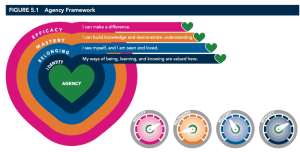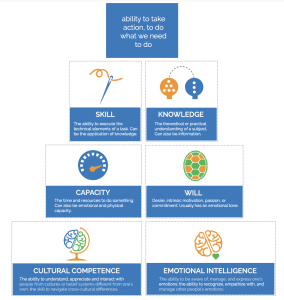As I engage in mid-year reflection on my goals as an instructional coach, I would like to share some of the tools I use to plan and engage in coaching meetings. I call these coaching meetings “partnership meetings” because both my colleague and I are learning together. It is my job, as a coach, to reflect on, and plan for the conversations. Intentional planning focuses on ensuring that conversations focus on my colleague’s goals and priorities, while centering students, especially our formerly marginalized students. In this post, and an upcoming part two, I want to summarize some useful coaching tools.
When I prepare for a coaching conversation, I try to ground myself in my colleague’s core values and the goals they have set as a part of our coaching cycle. We explore the core values early in our work together so I know their top three values around learning, at that time (as these change over time). Then I anchor in Core Human needs. I consider Aguilar’s Core Human Needs and Street Data’s Agency Framework.

–Safir and Dugan
“Agency is the idea that people have the capacity to take action, craft and carry out plans, and make informed decisions based on a growing base of knowledge… Agency doesn’t emerge in a vacuum, nor does it flourish in a traditional classroom where the teacher is positioned as a content expert dishing out knowledge. It emerges in a learning space where power is distributed, knowledge is democratized, diverse perspectives are welcomed and children are intellectually and emotionally nourished.” – Street Data
The Agency Framework centers on nurturing student agency and contains many of the same components as the Core Human Needs. Though the Agency Framework is designed to center student agency, I like that it includes Identity. I want to make sure I consider Identity when working with adults as well. Exploring our Identities as adults is a necessary component of equity work, beliefs, and behaviors. Here’s a synthesis of Core Human Needs and the Agency Framework:
- Belonging, relatedness – We all want to feel connected to others’ and to be seen, heard, cared for, and loved. This includes knowing that you can be your full self in this space. We have a genuine self-esteem, an unconditional sense of worthiness.
- Autonomy, agency – You are empowered and have a voice in what you do. We are co-designers.
- Mastery, competence – You feel effective at what you do. You can build knowledge and demonstrate understanding in a variety of ways.
- Trust and efficacy – You trust you have the resources to sustain yourself in life, and feel that you make a difference.
- Purpose, meaning – You know that you are part of something larger, and that something larger wouldn’t be the same if you weren’t a part of it.
- Identity – You have opportunities to explore the intersections of your identity, Your way of being and who you are as a learner are valued.
Next, as I prepare for a partner conversation, I think about my colleague’s strengths, both as they see them and as I see them. Historically many teachers have not had the opportunity to see themselves teach (through video, for example) or to receive ongoing feedback embedded in a cycle of continuous improvement. So I consider it my responsibility to help surface strengths they may not see yet… as well as blind spots or gaps. We all have gaps, and when we are aware of our gaps it helps us decide the most appropriate and useful next steps towards our goals. Aguilar’s Mind the Gap provides a framework for exploring gaps:

Aguilar suggests sharing the tool with partners, if you would find it useful. I haven’t yet done that but I have found it extremely useful for my reflection and preparation for the conversation. When I have a hunch about what gap is connected to a particular goal or strategy, it influences the questions I ask and the types of supports/scaffolds that might be most useful. Here are some examples:
- Is it a Skill gap? I could model the strategy, co-plan the language and scaffolds a teacher would use, or role play what the teacher could say to their students.
- Is it a Knowledge gap? I could provide resources and strategies, we could watch another teacher or a video, or I could share some ideas I have seen other teachers try.
- Is it a Capacity gap? We could work together to get a project started/completed. I could give space for an exploration of emotions, to attend to needs a colleague may need to meet before starting the task.
- Is it a Will gap? I could help the teacher see connections between the skill and their core values. We could explore the emotions around the skill. I could engage in co-teaching, shoulder to shoulder with the teacher.
- Is it a Cultural Competence gap? Exploring beliefs is a natural part of coaching, however if the gap is cultural competence, belief exploration becomes a top priority. This is where precise language to build trust and promote deep reflection is crucial. It is useful to use a “third point”. Third point is data, a rubric, or a resource that we can refer to to objectively explore and analyze. Examples of this data could include: student participation data, scripting the questions a teacher asks students, exploring an article or video on implicit bias, analyzing data by race and gender, using a checklist of high quality instructional practices, etc.
- Is it an Emotional Intelligence gap? I could provide objective observational data, based on an agreed upon focus. We could explore videotaping or audiotaping of practice to self-assess and reflect.
In Mind the Gap, Aguilar uses the term “resistant” and I want to explore that language. In an effort to use asset-based language in my thinking and speaking, and “resistant” can be a loaded term with a focus on deficit. This quote is useful capturing the way I strive to show up:
“Mind the Gap reminds us that when we see that someone is unable to do something that they want to do (or perhaps that we think they need to do) if we look at them as a learner, as someone who requires a set of things (skill, knowledge, capacity, will, emotional intelligence and cultural competence) in order to have an ability, then we can see opportunities for helping them grow. We remember that they are learners. We take the stance of guiding learning— rather than fighting resistance.” – Aguilar
I consider it a privilege to be invited into a coaching partnership, and recognize I am learning as much as my colleague!
In my next post, I want to share some of the language tools I use in partnership meetings. The more precise we are with language, the more impact our language can have! And as always, I look forward to hearing ideas from my readers! I know many of you are in coaching or leadership roles. What are your favorite “go to” tools?
Resources:
Street Data A Next-Generation Model for Equity, Pedagogy, and School Transformation, Safir and Dugan
Mind the Gap, Aguilar
Core Human Needs, Aguilar
Core Values, Aguilar